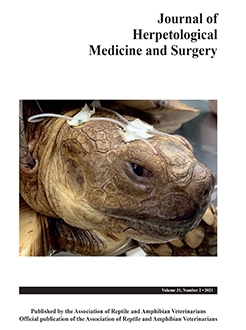The coccidian parasite Choleoeimeria pogonae infests the biliary ducts and gallbladder of the central bearded dragon (Pogona vitticeps). Endogenous C. pogonae development occurs in the epithelium of the gallbladder and bile ducts, leading to significant tissue injury. To determine whether bile composition in the gallbladder was disrupted by the parasite, bile samples were collected from one normal and one C. pogonae–infected central bearded dragon. Bile acid species were identified and quantified with liquid chromatography and mass spectroscopy. Tauroallochoic acid was the predominant bile acid (82.2%) in the normal bearded dragon, whereas the deconjugated allocholic acid was the predominant bile acid (40.1%) in the bearded dragon with C. pogonae. Taurine conjugation inhibits calcium precipitation in bile and bile acid–mediated ductal epithelial cytotoxicity. The shift in bile acid content identified in the C. pogonae infected bearded dragon may contribute to cholelithiasis and mucosal damage.
How to translate text using browser tools
26 July 2021
Choleoeimeria pogonae Alters the Bile Acid Composition of the Central Bearded Dragon (Pogona vitticeps)
Andrea N. Johnston,
Anke C. Stöhr,
Charles Artiles,
Nathalie Rademacher
ACCESS THE FULL ARTICLE
It is not available for individual sale.
This article is only available to subscribers.
It is not available for individual sale.
It is not available for individual sale.
bile acids
bile salt hydroxylase
central bearded dragon
Choleoeimeria pogonae
Pogona vitticeps





